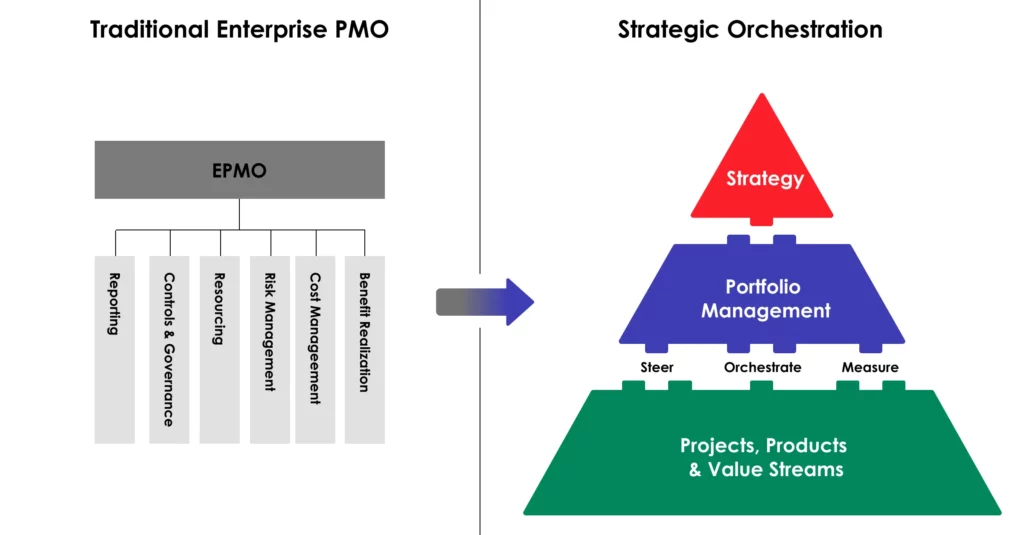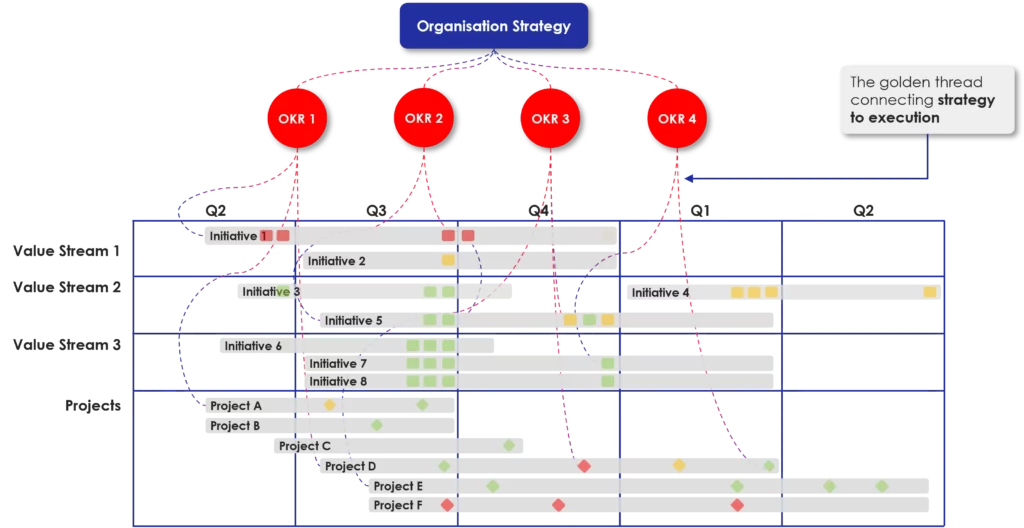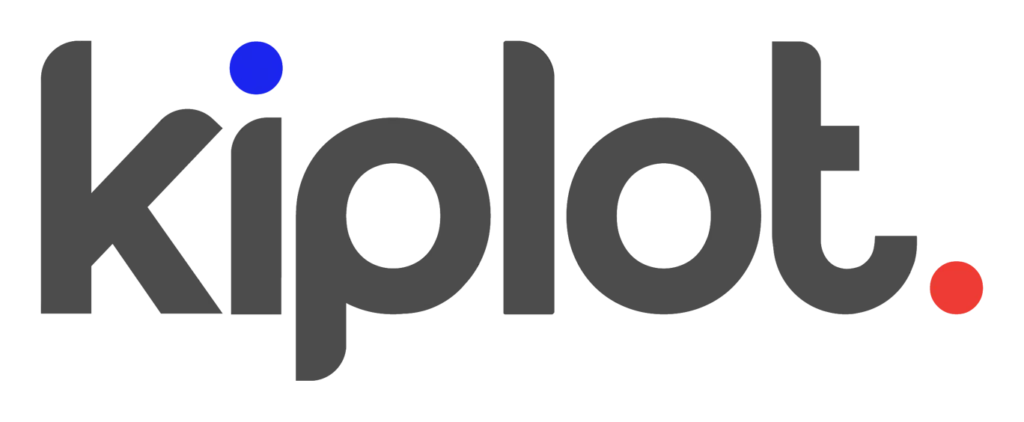Today's enterprise organization is a complex ecosystem of initiatives, products, and value streams – some following traditional project structures, others operating in agile, and many blending both. Moving at high speed, each with interdependencies and risks, they require coordination to function effectively. Strong coordination drives execution; its absence leads to chaos.
The PMO's role has fundamentally changed. What was once primarily a passive reporting function now serves as the enterprise's air traffic control tower – aligning initiatives, handling complex dependencies, and guiding execution. Without this direction, organizations experience fragmented execution, competing priorities, and ineffective investments.

From Radar Operator to Orchestrator
Traditional PMOs functioned much like radar operators: tracking work after it happened, producing reports, and ensuring compliance. These activities provided oversight but failed to actively influence how work got done.
But today, real-time data and automated reporting have made passive tracking obsolete. Modern PMOs must orchestrate rather than observe – guiding work dynamically, clearing bottlenecks as they emerge, and connecting strategic priorities to tangible results.
| Traditional PMO (Radar Operator) | Modern PMO (Air Traffic Control Tower) |
|---|---|
| Passive tracking and reporting | Active steering and orchestration |
| Focused on compliance & governance | Focused on business outcomes & execution |
| Reacts to problems after they arise | Anticipates and resolves bottlenecks proactively |
| Manages projects in silos | Coordinates across projects, products, and value streams |
| Heavy reliance on slide decks | Provides real-time insights for decision-making |
Organizations that fail to make this transition will find that business leaders bypass the PMO in favor of direct, real-time visibility. This transition isn't a future possibility, it’s unfolding right now in organizations everywhere.
PMO as "Air Traffic Control Tower"
Aviation relies on air traffic control to coordinate flights and maintain safety. Even the most skilled pilots with advanced aircraft need this coordination to navigate crowded airspace effectively.
The PMO plays the same role for an organization’s strategic execution. Its focus has evolved from passive tracking to active guidance:
- Ensuring strategic alignment – making certain that initiatives directly support business objectives.
- Proactively managing dependencies across both traditional and agile teams.
- Facilitating resource allocation to maximize value delivery.
- Balancing top-down strategic demand with bottom-up execution realities to ensure continuous alignment.
Similar to how air traffic controllers coordinate diverse aircraft operating under different conditions and requirements, effective PMOs orchestrate across various delivery methodologies. They create coherence whether teams use agile, waterfall, or blended approaches.
The four strategic imperatives for the modern PMO
1. From reporting to real-time decision enablement
What?
Traditional reporting rarely drives value today; leaders now expect actionable insights available on demand.
Why?
The expectation for “real-time” reporting is often misunderstood. The real value lies in automation, not just speed. A dashboard that updates in real-time but is only reviewed once a week provides little advantage. The focus should be on eliminating manual intervention in data flows so information becomes available when needed without human intervention.
Just as payments optimize for Straight Through Processing (STP), PMOs must optimize for direct, unfiltered data flows.
How?
- Shift from manually compiled reports to automated, integrated dashboards that pull directly from execution tools.
- Eliminate unnecessary manual reviews by establishing trust in automated data pipelines.
💡 Read more on industry best practice reporting: Transforming enterprise reporting into strategic intelligence.
2. Orchestrate across traditional and agile teams
What?
Enterprises increasingly operate in hybrid environments. A rigid, one-size-fits-all approach no longer works.
Why?
The true challenge isn’t just reporting on initiatives. Many enterprises struggle as teams grapple with dependencies while competing for resources and attention. Without proper coordination, initiatives crash into each other. Resources get stretched thin. Strategic alignment suffers.
How?
- Manage the enterprise backlog of initiatives, ensuring that new work only "lands" when there is available capacity.
- Proactively resolve dependencies between teams working in different models (project-based, agile squads, product teams, etc.).
- Use structured demand management to ensure work is continuously aligned with strategic priorities.
💡 Read more on Capacity Planning and orchestration: Exploring the “why” of agile capacity planning?
3. Be masters of financials and value realization
What?
The PMO must take direct ownership of financial oversight. This includes connecting work to spending, maintaining budget accuracy, and tracking delivered value.
Why?
The connection between execution and financials has become increasingly fragmented. In traditional project structures, the relationship between a project code in an ERP system and work on the ground was clearer. Today, with agile delivery, cross-functional teams, and fluid investment models, financial control is often reactive rather than proactive.
How?
- CapEx vs. OpEx tracking: Ensure capitalized and operational expenditures align with financial strategy (learn more here).
- Forecast vs. actuals analytics: Move beyond static annual budgeting to continuous financial intelligence.
- Value tracking: Instead of just measuring delivery progress, establish quantifiable financial impact metrics.
💡 Read more on Financial Control: Lean Project Accounting Whitepaper.
4. Take ownership of strategy execution

What?
Modern PMOs drive organizational success, not just administrative tasks.
Why?
Strategic alignment requires more deliberate action than just governance. PMOs must define "golden thread" that connects the organization’s strategic priorities to the actual work being delivered.
Leadership teams need to understand:
- Which initiatives drive revenue?
- Which initiatives enable the ESG agenda?
- Which initiatives are AI enablers?
Understanding this execution mix is critical for making strategic trade-offs. The air traffic control metaphor applies here too. Just as ATC ensures the right planes land in the right sequence, PMOs ensure the right investments are made at the right time to maximize impact.
How?
- Establish a clear mapping between initiatives and strategic objectives.
- Develop a portfolio-wide execution mix dashboard that enables leadership to steer investment priorities dynamically.
- Implement iterative review cycles to assess whether the execution landscape remains aligned to business needs.
The PMO’s future: A strategic evolution
There is a growing misconception that automation and agile methodologies diminish the need for a PMO. In fact, orchestration matters more now than before – especially for organizations that position their PMO as a strategic enabler rather than merely enforcing governance.
PMOs and transformation teams that embrace this shift will become central to enterprise success, driving efficiency, alignment, and measurable impact. Those that do not risk being sidelined.
Organizations have a choice: evolve the PMO into a strategic orchestrator or allow its influence to fade.
The future belongs to those who take control. Be the air traffic control tower – or risk being grounded.

